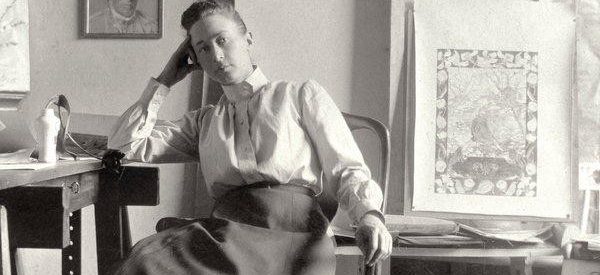 ?The Ten Largest? (1907) at the Museum of Modern Art Stockholm, 2013 Photograph: sa Lundn
?The Ten Largest? (1907) at the Museum of Modern Art Stockholm, 2013 Photograph: sa Lundn
The art world has been knocked off its feet by Hilma af Klint. Shaken by a completely unknown woman artist who, 69 years after her death, challenges the historic timeline and authorship of abstract painting. af Klint?s work is bright, bold, often monumental in scale, and decidedly non-representative in nature. Her paintings flatten 2-dimensional space in a way that pre-dates Wassily Kandinsky and the modernists by a few years that has initiated a debate about who invented abstract painting.
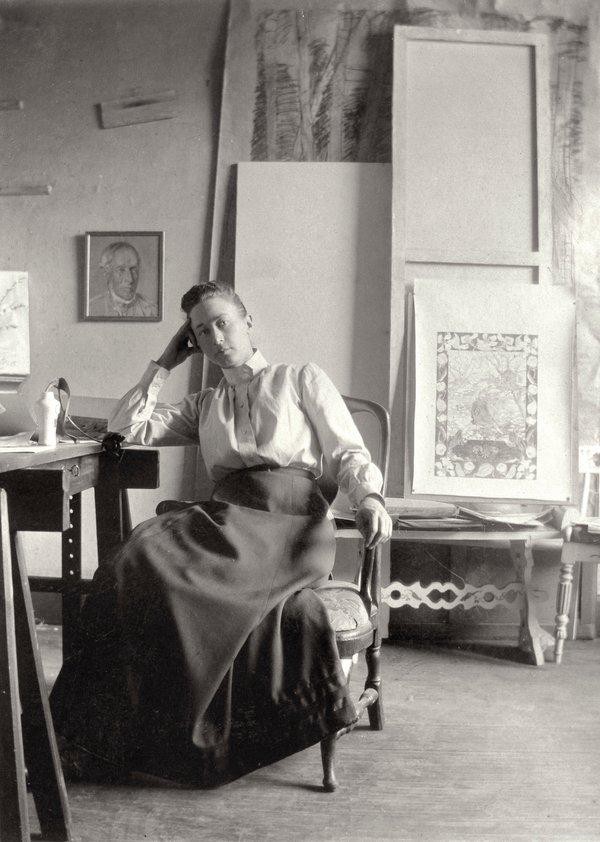 Hilma af Klint in her studio in 1895
Hilma af Klint in her studio in 1895
It gets even more interesting ?shortly after graduating with honors from the Royal Academy of Fine Arts in Sweeden, Hilma af Klint rejected her formal training in favor of Spiritualism and joined Madame Blavatsky?s Theosophical Society in 1889. There she met four other like-minded women and founded ?The Five? in 1896. The group held spiritual sances, regularly communicating with spirits, taking detailed notes and practiced automatic drawing.
Then in 1904, after eight years of esoteric training with ?The Five?, Hilma af Klint was instructed by the spirit world to carry out a major assignment: a series of works called the ?Paintings for the Temple.? This ambitious vision from beyond was to be a series of paintings installed in a specially designed spiral temple that would facilitate spiritual meditation on the transcendent reality beyond the physical world. This astral plane commission would occupy af Klint for the next nine years.
 Hilma af Klint, ?The Ten Largest, ?4, Youth?, 1907
Hilma af Klint, ?The Ten Largest, ?4, Youth?, 1907
For the rest of her life, af Klint?s metaphysical research would continue, often extending into semi-scientific visual research, but she never truly exhibited or shared her work with the world. She led a quiet life, largely spent inwardly focused on her mediumistic artwork. When she died in 1944, she left a huge archive of 1,300 paintings and 125 notebooks to her nephew Erik af Klint, a naval officer. She left a note that explicitly stated that her work could not be exhibited until 20 years after her death and that the collection could never be split up.
Now, 74 years after her death, the Guggenheim Museum hosts ?Hilma af Klint: Paintings for the Future? now on view in NYC until April 23rd, 2019. The first major exhibition of her work in the United States, it?s being hailed as one of the most globally important exhibitions of the decade with preeminent critics lining up to heap praise on af Klint?s fascinating story and newfound place in art history.
 Hilma af Klint ?Evolution, ?15, Group IV, The Seven-pointed Stars?, 1908
Hilma af Klint ?Evolution, ?15, Group IV, The Seven-pointed Stars?, 1908
Abstraction vs Visualization
My interest in af Klint?s work is to explore her relation to scientific visualization. Many voices in the art world are claiming that af Klint?s works represent the ?first? abstract paintings, but I think they are jumping to the wrong conclusion. I think her motivation was actually to visualize spiritual concepts. They see this as presaging abstract expressionism when really it?s part of a movement toward diagramming the immaterial world. The two concepts are very different.
 Wassily Kandinsky, ?Composition IV?, 1911 link
Wassily Kandinsky, ?Composition IV?, 1911 link
Abstraction in the visual arts is the practice of focusing on the elements of the work of art itself. We see this in Kandinsky?s focus on color and line as a means to themselves, Mondrian?s gridded compositions, Picasso?s fracturing of the picture plane, and Pollack?s dripping paint. The elements that comprise a painting are the focus of the work, aesthetics the outcome. In 1911, Kandinsky himself refers to the work ?Composition IV? as ?The relation of the light, delicate and cold to the sharp movement (war) makes the main contrast in the picture.?
Of course, abstraction (or formalism) isn’t meaningless either. We know each of the artists above folded additional layers of meaning into their work: Kandinsky?s synesthetic conversion of music, Mondrian?s graphic analogies to the city, Picasso?s inspiration from the invention of the X-ray and Pollack?s interest in the mandala.
Visualization, on the other hand, is entirely different.
The 19th-century was filled with invention. Not only was the term visualization invented in 1883, but various types of visualization shaped how the sciences were presented to the world. Mendeleev?s invention of the periodic table in 1869 was represented in the form of a chart. Tales of mechanical innovation were initially spread by illustration, then by black and white photographs.
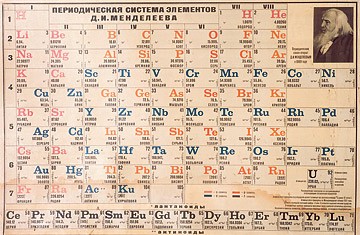 A Russian periodic table based on Dmitri Mendeleev?s original, 1869
A Russian periodic table based on Dmitri Mendeleev?s original, 1869
The Oxford English Dictionary defines the term ?visualization? as ?depicting the formation of mental images of things not actually present in sight.? In Orit Halpern?s great book ?Beautiful Data: A History of Vision and Reason since 1945? he elaborates:
?Visualization slowly mutated from the description of human psychological processes to the larger terrain of rendering practices by machines, scientific instrumentation, and numeric measures. Most important, visualization came to define bringing that which is not already present into sight? Visualizations are about making the inhuman, that which is beyond or outside sensory recognition, relatable to the human being.?
Scientific illustration and Theosophical Visualization
Seeing as the Theosophical Society was an organization formed to advance the ?study and elucidation of Occultism? and ?encourage the study of comparative religion, philosophy, and science.? It only makes sense that the Spiritualists would incorporate the language of scientific visualization when transcribing the astral plane. Curator Iris Mller-Westermann explains: ?You have to understand this was the age when natural sciences went beyond the visible: Heinrich Hertz discovered electromagnetic waves [in 1886], Wilhelm Rntgen invented the x-ray [in 1895].?
 The Line of Grace from ?The Principles of Light and Color? link
The Line of Grace from ?The Principles of Light and Color? link
One of the best examples of this study can be found in Edwin D. Babbitt, whose 1878 book ?The Principles of Light and Color: The Harmonic Laws Of The Universe, The Etherio-Atomic Philosophy Of Force, Chromo Chemistry, Chromo Therapeutics, And The General Philosophy Of The Fine Forces, Together With Numerous Discoveries And Practical Applications.? With a title like that, it?s no wonder Klint was a fan.
 ?Unity? from ?The Principles of Light and Color? link
?Unity? from ?The Principles of Light and Color? link
Babbitt?s first chapter ?Harmonic Laws of the Universe?, is essentially a spiritualist translation of scientific theory that spans biology, physics, sociology, and architecture. Each discipline is described using largely artistic terms such as light, shade, and hue and contextualized with similar looking examples. ?Unity? is seen in the forms of snowflakes, microsomes, and geometric diagrams. ?Gradiation or Progression? ?may be seen in the forms of many grasses, leaves, flowers, shells, streams, etc. is called the line of grace, named also by Hogarth, and is a spiral. It is seen in the climbing of vines as they encircle a tree, in many seashells.?
 Snowflakes photographed by Wilson Bentley (1902) link
Snowflakes photographed by Wilson Bentley (1902) link
The Theosophical exploration of scientific illustration quickly became entangled with astral visualization. The first photographs of snowflakes became indirect evidence of sublime symmetry. The diagrammed veins of a leaf used to underscore the profundity of divine computation.
af Klint was born into an educated home; her father was a military officer, her two brothers were scientists and she held a life-long interest in Botany. ?The Harmonic Laws of the Universe? clearly had an important influence on af Klint, its changing focus from macro to micro evident in many of Klint?s paintings. We see a botanical line in af Klint?s paintings that represent ?a parallel world with unities within unities.? Flowers become dimensions become cells become natural forces at play on human consciousness.
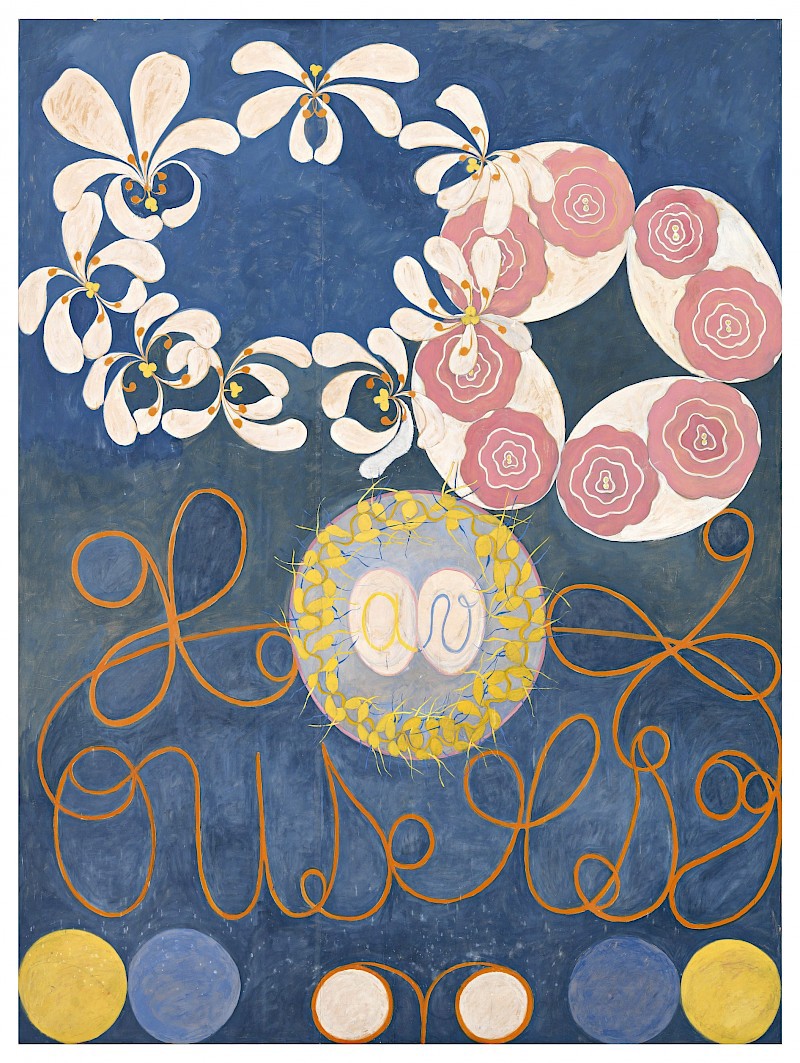
Another book that clearly had an influence on af Klint was ?Thought-Forms? by Annie Besant and C.W. Leadbeater. It begins ?As knowledge increases, the attitude of science towards the things of the invisible world is undergoing considerable modification. Its attention is no longer directed solely to the earth with all its variety of objects, or to the physical worlds around it; but it finds itself compelled to glance further afield, and to construct hypotheses as to the nature of the matter and force which lie in the regions beyond the ken of its instruments.?
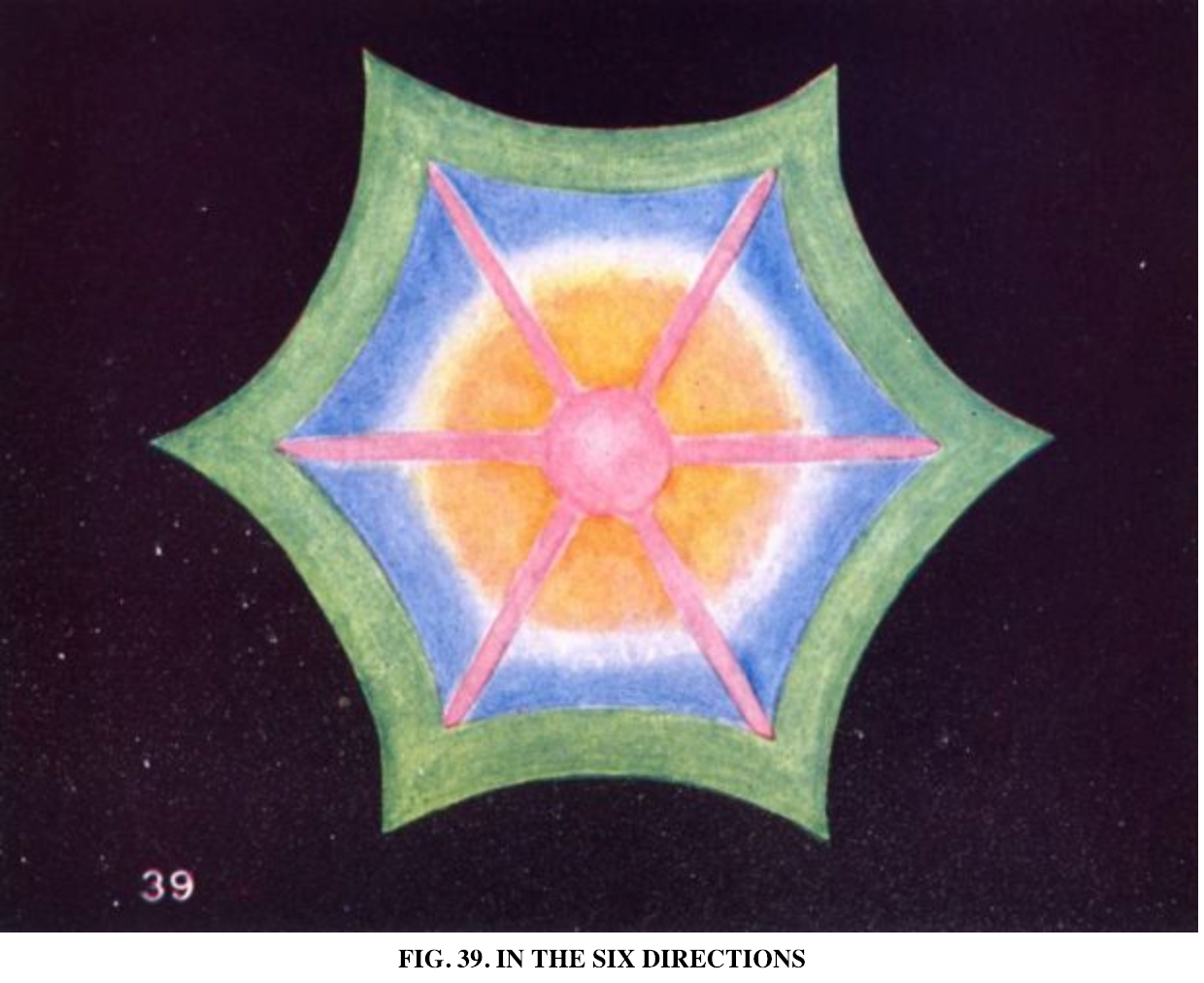 ?endeavor to extend love and sympathy in all directions? from ?Thought-Forms? Besant and Leadbeater, 1901 link
?endeavor to extend love and sympathy in all directions? from ?Thought-Forms? Besant and Leadbeater, 1901 link
Published in 1901 by the Theosophical Society, ?Thought-Forms? is an exploration of how multiple forms of thought are transmuted into various spiritual planes. It covers subjects like ?How the Vibration Acts?, ?The Meaning of Colours?, and ?Illustrative Thought-Forms.? This last section takes up the majority of the book and pairs abstract watercolor paintings with their thought correlations.
For example: ?In the Six Directions. ? The form represented in Fig. 39 is the result of another endeavor to extend love and sympathy in all directions ? an effort almost precisely similar to that which gave birth to [sympathy and Love for all]. The reasons for this variety and for the curious shape taken in this case constitute a very interesting illustration of the way in which thought-forms grow.?
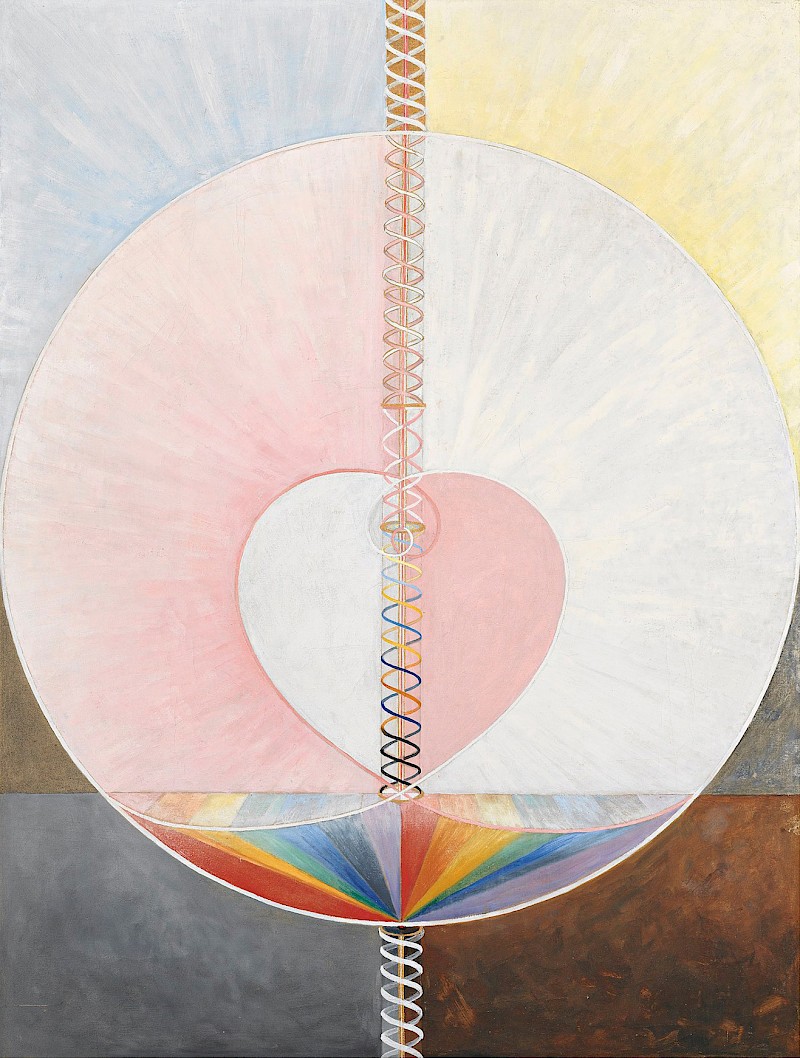 Hilma af Klint, ?Group IV, The Ten Largest, ?1, Childhood? (1907)
Hilma af Klint, ?Group IV, The Ten Largest, ?1, Childhood? (1907)
Undoubtedly af Klint was deeply enmeshed in these theories. Her paintings combine so many aspects of scientific illustration, geometry, color theory, and linguistics with a Theosophical appreciation for organic forms. Yet her paintings were not just a combination of these elements.
af Klint was inspired to craft her own highly nuanced, totally unique visualizations of the astral world. Her use of color and form were not a means to themselves, her compositions were representations of abstract concepts. Each color, each shape, the arrangement in the composition are not abstractions, but visual descriptions of ethereal concepts outside of human sensory recognition.
While af Klint was using the language of abstraction before the modernists, her paintings are not abstract ? they are representations of the extended scientific and Theosophical concepts she was immersed in. af Klint dedicated her life to transmuting the spiritual realm into art for meditative study. Her paintings were not (and still are not) for sale and they were not made to fit into a marketplace.

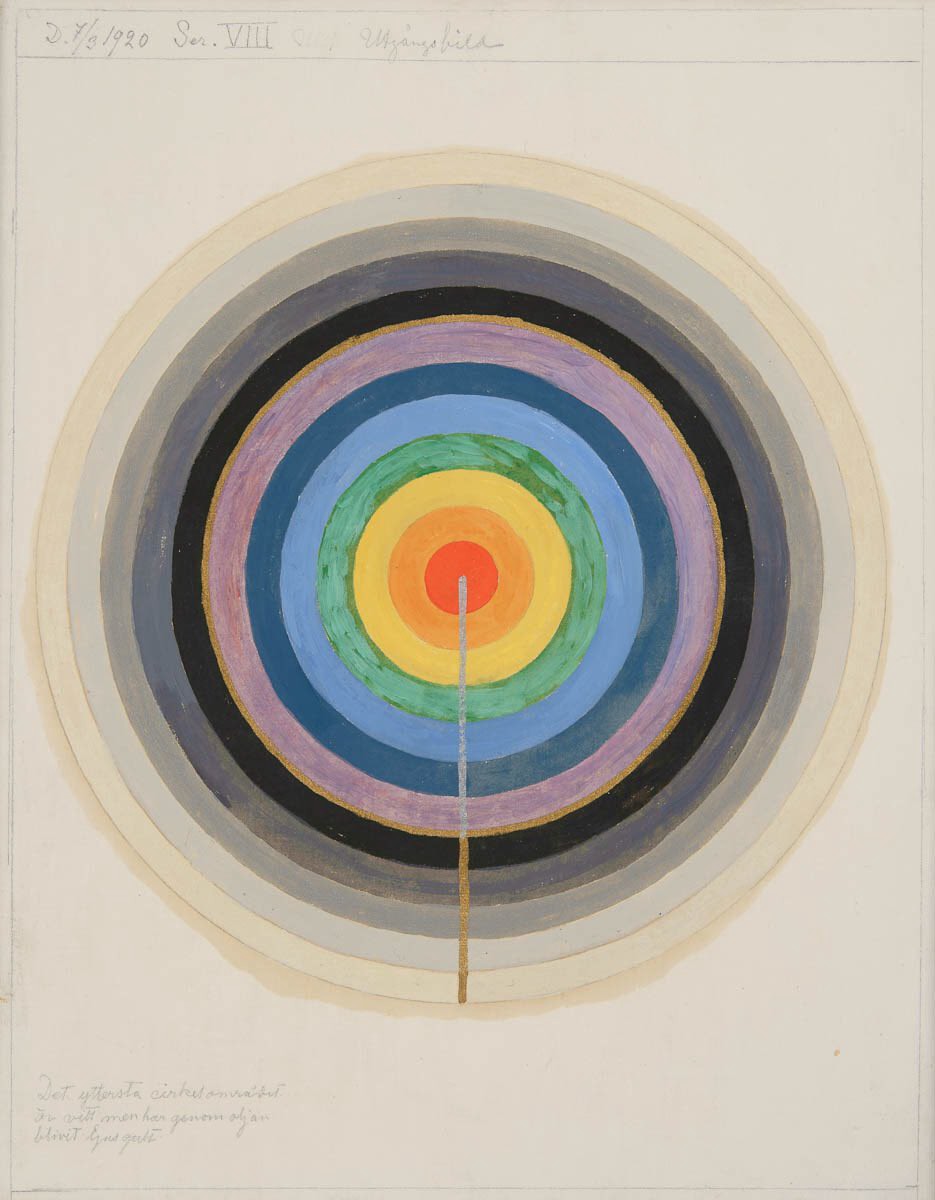 LEFT ? Edwin D. Babbitt, ?The Principles of Light and Color?, 1878 RIGHT ?Hilma af Klint ?Series VIII. Picture of the Starting Point?, 1920
LEFT ? Edwin D. Babbitt, ?The Principles of Light and Color?, 1878 RIGHT ?Hilma af Klint ?Series VIII. Picture of the Starting Point?, 1920
Challenging historical concepts
For being roughly a century old, Hilma af Klint?s work is surprisingly now. Ben Davis writing in Artnet elaborates, ?Now happens to be a very exciting moment in art history, with loads of new scholarship disrupting the old Paris-to-New York, Modern-to-contemporary throughline, reconsidering the stories of minorities and the colonized, ?outsiders? of all kinds, and also of women.?
Georg Imdahl, a professor at the Academy of Fine Arts Mnster in Germany and an art critic for the daily Sddeutsche Zeitung, is more hesitant on the matter, clearly highlighting the disruption to the cannon. ?She developed somehow outside the art scene of the time, so I think we need to learn more about her intentions as an artist? That said, there are several of her works which I would consider integrating into a discussion of the genesis of 20th-century abstraction.?
I?ll conclude with the preeminent art critic Roberta Smith of the New York Times. She eloquently explains why this work is finding such profound resonance with a global art audience today:
?Her century-old paintings come to us relatively unencumbered by critical or historical baggage. Their spare planes of color and stylistic diversity tie them to the present, underscoring how many painters, especially women, are reinvigorating abstraction by making it flexible and worldly. However af Klint?s achievement alters the past, it belongs to us. Its history begins now.?
There is much more to read about af Klint?s work online. Here?s a selection of great articles, starting with her official history at the Hilma af Klint foundation.
About Hilma af Klint –
Hilma af Klint (1862-1944) made her international debut with the exhibition The Spiritual in Art – Abstract Paintings?
www.hilmaafklint.se
Why Hilma af Klint’s Occult Spirituality Makes Her the Perfect Artist for Our Technologically?
I can’t help but agree with all the praise being heaped on the Guggenheim’s big Hilma af Klint show. It’s great, great?
news.artnet.com
Hilma af Klint: a painter possessed
Was Hilma af Klint Europe’s first abstract artist? As an exhibition of her extraordinary, occult-inspired works opens?
www.theguardian.com
‘Hilma Who?’ No More
Critic’s Pick Spiritual sparks helped inspire the radical and visionary art of Hilma af Klint, the new (old) name to?
www.nytimes.com
Hilma af Klint’s Visionary Paintings
One work amid the hundreds in a flabbergasting retrospective, “Hilma af Klint: Paintings for the Future,” at the?
www.newyorker.com
Thanks a ton to Tyler Curtis and Elijah Meeks for the copy edits!
